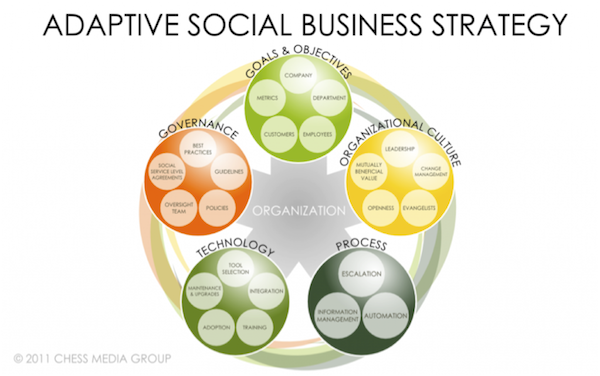Linear approaches to enterprise collaboration and/or social CRM aren’t pragmatic or realistic. Organizations looking to implement either customer-facing or employee-facing social initiatives (a.k.a. enterprise 2.0 and social CRM) need an adaptive social business framework.
Months of interviews with clients and organizations, case study research, and observations has led to the development of the following social business framework:

Here’s a closer look at each of the five key areas:





Why an Adaptive Social Business Model is Needed
The trouble with many social business models today is that they don’t allow room for adaptation and manipulation; they put organizations into a box and expect them to move in a linear way to get to their goal, not being able to move forward until each preceding step is completed.
Problem is, every organization has different needs in different areas. The point of developing something like this is to address and show the common elements among organizations that are investing in social business while allowing the flexibility of every organization to focus on the necessary areas.
How This Can Help Your Organization
Some organizations might have a rock solid organizational culture, a solid process, and a great technology stack but might be weak in the goals and objectives and governance areas. This framework is designed to let organizations look at and understand the key components that make up each sphere.
Your organization might be great at one of the five areas, whereas another organization might be solid at three of the five.
Organizations can maneuver through this framework to improve on areas where they are weak or perhaps not as strong as they would like to be. It’s adaptive because it doesn’t force organizations down a single path – yet addresses the key areas for social business.
Every organization can determine which areas they need to work on and which ones are solid.
While the framework uses the term “social” the reality is that many of the concepts are built around traditional approaches to business but in this case slightly adapted specifically to organizations interested in emergent social software. As Gil Yehuda has said, “it’s very healthy to view a social initiative as a business initiative.”
Going Further
We realize this is a first step. We’re working on follow up in the form of a maturity model to help guide organizations further.
But before we get there, we wanted to release our ideas as we’re working on them to be able to incorporate any feedback from the community. Please leave your thoughts, ideas, and comments below; let’s discuss!





